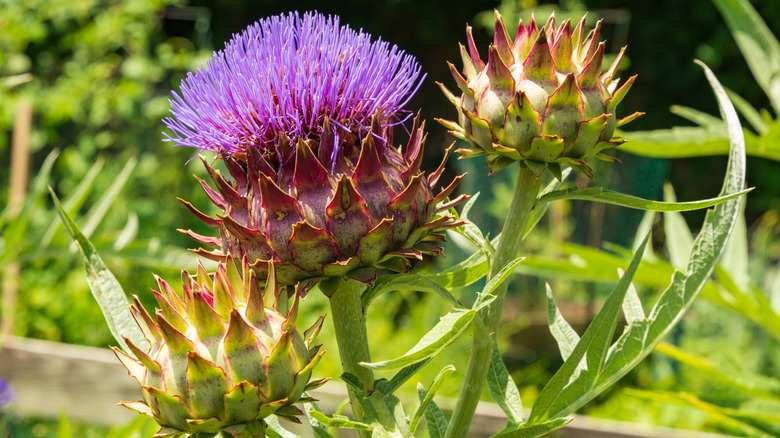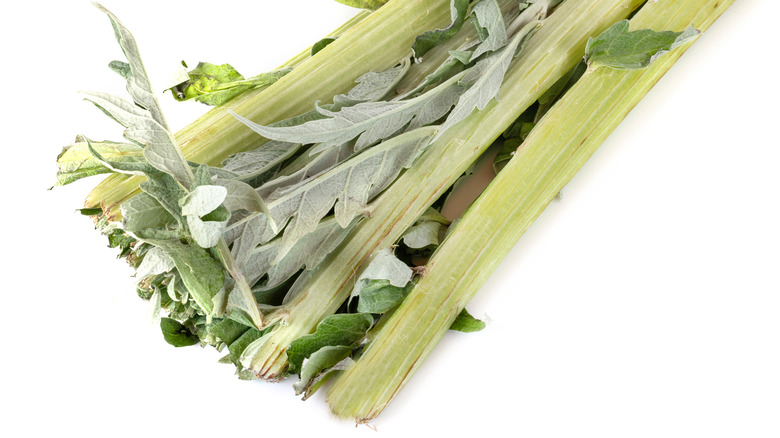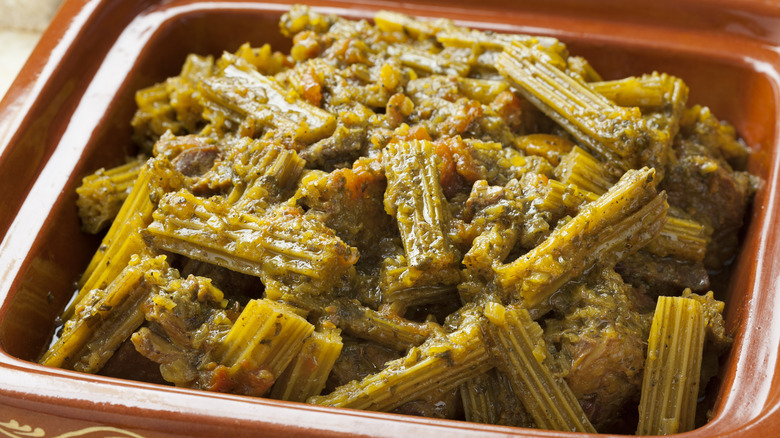What Is A Cardoon And How Are They Different From Artichokes?
While you may be heavily reliant on what you see in front of you when seeking out delicious ingredients, using your sight alone to differentiate between foods isn't always the most accurate method. For example, if you were to accidentally pick up a bunch of mint when your dish actually called for oregano, which is similarly round and serrated, you'd end up eating breakfast eggs or tomato sauce with an astringent toothpaste taste instead of pleasing savory notes.
If there is an ingredient worth mimicking, it's the artichoke, which is loaded with both fiber and antioxidants. While ubiquitous now, in early 1900s America, anyone able to effectively market an artichoke alternative would've made a pretty penny, though they would have had to contend with the mafia, which for years controlled artichoke imports on the East Coast.
Many people, when confronted with a cardoon, would immediately assume that they were looking at an artichoke. But while cardoons, much like artichokes, are also delicious and nutritious, the two foods are surprisingly unique in key ways.
How to differentiate between cardoons and artichokes
If you find yourself walking in a Mediterranean meadow this spring season, you'll likely encounter both of these vegetables growing wild. But in order to utilize artichokes or cardoons to the fullest extent, knowing how to tell them apart is essential. It's easy to see how someone could get them mixed up. The two plants each have long stalks that end in beautiful budding flowers. Both are members of the genus Cynara, so their shared physical features shouldn't be all that shocking.
However, attempting to cook an artichoke and a cardoon in the same fashion will likely result in an unpleasant eating experience. To prepare an artichoke, you must delicately turn its flower against your knife, removing the tough outer leaves and exposing the meaty heart. While cardoon flowers are technically edible (they're used as an alternative to animal rennet in cheesemaking), the culinary sphere has honed in on the plant's thick stem. A cardoon stem, in the absence of its bitter exterior, tastes like roasted artichoke, yet has a length and structure comparable to celery.
Cardoons as a crop and in cuisine
While artichokes and cardoons are perennial (meaning that they bloom every year, and the lifespan of both plants is around five years), the latter are such a coveted crop because they're incredibly impractical. Only a fraction of a massive cardoon plant consists of anything remotely delicious; the rest has been deemed inedible. Luckily, the usable parts — the stems — are quite tasty.
There is no shortage of different ways to enjoy cardoons. If you want a simple snack, all you need to do is peel them and dip them raw in the spread or sauce of your choosing. A similar crunchy and healthy raw stick snack made from jicama is sold by Jica Foods. As cardoons are rather mild, they hold up to myriad cooking styles. However, if you want the cardoons to turn out tender, it could help to give them an hour-long bath in a boiling mixture of water and acidic liquid (think lemon juice or vinegar).
If you're a fan of artichokes and want to try their curious, stem-heavy vegetable cousin cardoons, consider going big and making some cardoon soup with black truffle carpaccio. Alternatively, you could take a page from chef Anna Klinger of Brooklyn's enduring trattoria Al Di La and cook your cardoons with fonduta in a traditional preparation from Piedmont.


